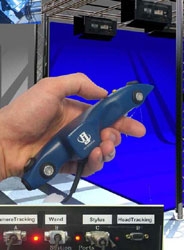 |
Abstract: Markerless Actor Tracking for Virtual (TV) Studio Applications
Jeff Daemen, Peter Haufs-Brusberg, and Jens Herder. Markerless Actor Tracking for Virtual (TV) Studio Applications, International Joint Conference on Awareness Science and Technology & Ubi-Media Computing (iCAST 2013 & UMEDIA 2013), HC-2013 Track, DOI 10.1109/ICAwST.2013.6765544, Hamamatsu/Aizu-Wakamatsu/Duesseldorf, November, 2013.
Virtual (TV) studios gain much more acceptance through improvements in computer graphics and camera tracking. Still commercial studios cannot have full interaction between actors and virtual scene because actors data are not completely digital available as well as the feedback for actors is still not sufficient. Markerless full body tracking might revolutionize virtual studio technology as it allows better interaction between real and virtual world. This article reports about using a markerless actor tracking in a virtual studio with a tracking volume of nearly 40 cubic meter enabling up to three actors within the green box. The tracking is used for resolving the occlusion between virtual objects and actors so that the renderer can output automatically a mask for virtual objects in the foreground in case the actor is behind. It is also used for triggering functions scripted within the renderer engine, which are attached to virtual objects, starting any kind of action (e.g., animation). Last but not least the system is used for controlling avatars within the virtual set. All tracking and rendering is done within a studio frame rate of 50 Hz with about 3 frames delay. The markerless actor tracking within virtual studios is evaluated by experts using an interview approach. The statistical evaluation is based on a questionnaire.
Keywords:
virtual studio, markerless tracking
Markerless Actor Tracking for Virtual (TV) Studio Applications >>
VRON: Virtual Reality over Networks - Die vier Stadien in einer digitalen Welt im Virtuellen Studio: Mensch, Cyborg, Avatar, Bot >>
|
 |
